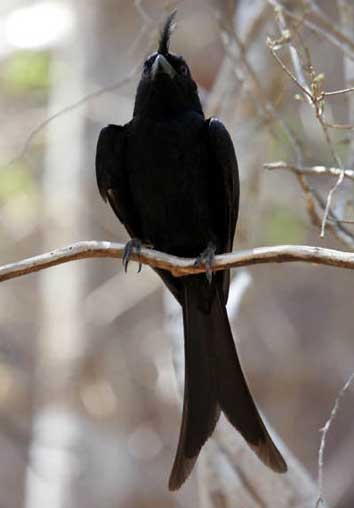
Dicrurus forficatus (*)
Superregnum: Eukaryota
Cladus: Unikonta
Cladus: Opisthokonta
Cladus: Holozoa
Regnum: Animalia
Subregnum: Eumetazoa
Cladus: Bilateria
Cladus: Nephrozoa
Superphylum: Deuterostomia
Phylum: Chordata
Subphylum: Vertebrata
Infraphylum: Gnathostomata
Megaclassis: Osteichthyes
Cladus: Sarcopterygii
Cladus: Rhipidistia
Cladus: Tetrapodomorpha
Cladus: Eotetrapodiformes
Cladus: Elpistostegalia
Superclassis: Tetrapoda
Cladus: Reptiliomorpha
Cladus: Amniota
Classis: Reptilia
Cladus: Eureptilia
Cladus: Romeriida
Subclassis: Diapsida
Cladus: Sauria
Infraclassis: Archosauromorpha
Cladus: Crurotarsi
Divisio: Archosauria
Cladus: Avemetatarsalia
Cladus: Ornithodira
Subtaxon: Dinosauromorpha
Cladus: Dinosauriformes
Cladus: Dracohors
Cladus: Dinosauria
Ordo: Saurischia
Cladus: Eusaurischia
Subordo: Theropoda
Cladus: Neotheropoda
Cladus: Averostra
Cladus: Tetanurae
Cladus: Avetheropoda
Cladus: Coelurosauria
Cladus: Tyrannoraptora
Cladus: Maniraptoromorpha
Cladus: Maniraptoriformes
Cladus: Maniraptora
Cladus: Pennaraptora
Cladus: Paraves
Cladus: Eumaniraptora
Cladus: Avialae
Infraclassis: Aves
Cladus: Euavialae
Cladus: Avebrevicauda
Cladus: Pygostylia
Cladus: Ornithothoraces
Cladus: Ornithuromorpha
Cladus: Carinatae
Parvclassis: Neornithes
Cohors: Neognathae
Cladus: Neoaves
Cladus: Telluraves
Cladus: Australaves
Ordo: Passeriformes
Subordo: Passeri
Infraordo: Corvida
Superfamilia: Corvoidea
Familia: Dicruridae
Genus: Dicrurus
Species: Dicrurus forficatus
Subspecies: D. f. forficatus – D. f. potior
Name
Dicrurus forficatus (Linnaeus, 1766)
Synonyms
Lanius forficatus (protonym)
References
Linnaeus, C. 1766. Systema naturae per regna tria naturae, secundum classes, ordines, genera, species, cum characteribus, differentiis, synonymis, locis. Editio duodecima, reformata. Tomus 1 (Regnum Animale), Pars 1: 1–532. Holmiæ [Stockholm]. Impensis Direct Laurentii Salvii. p. 134 BHL Reference page.
Vernacular names
español: Drongo Malgache
The crested drongo (Dicrurus forficatus) is a passerine bird in the family Dicruridae. It is black with a bluish-green sheen, a distinctive crest on the forehead and a forked tail. There are two subspecies; D. f. forficatus is endemic to Madagascar and D. f. potior, which is larger, is found on the Comoro Islands. Its habitat is lowland forests, both dry and humid, and open savannah country. It is a common bird and the IUCN has listed it as "least concern".
Taxonomy
In 1760 the French zoologist Mathurin Jacques Brisson included a description of the crested drongo in his Ornithologie based on a specimen collected in Madagascar. He used the French name Le grand gobe-mouche noir hupé de Madagascar and the Latin Muscicapa Madagascariensis nigra major cristata.[2] Although Brisson coined Latin names, these do not conform to the binomial system and are not recognised by the International Commission on Zoological Nomenclature.[3] When in 1766 the Swedish naturalist Carl Linnaeus updated his Systema Naturae for the twelfth edition, he added 240 species that had been previously described by Brisson.[3] One of these was the crested drongo. Linnaeus included a brief description, coined the binomial name Lanius forficatus and cited Brisson's work.[4] The specific name forficatus is Neo-Latin for "scissor-shaped".[5] This species is now placed in the genus Dicrurus that was introduced by French ornithologist Louis Jean Pierre Vieillot in 1816.[6]
Two subspecies are recognised:[7]
D. f. forficatus (Linnaeus, 1766) – Madagascar and nearby islands
D. f. potior (Bangs & T E Penard, 1922) – island of Anjouan, Comoros
The common name of drongo, now applied to all members of the family Dicruridae, was originally a Malagasy word from the Betsimisaraka dialect; more commonly it is called railovy in Malagasy.[8]
Description
The adult male and female are almost entirely black, with a blue-green sheen. The distinctive crest consists of elongated feathers on the forehead. The forked tail is also distinctive of the adult birds. D. f. potior is larger and has broader tail feathers.[9]
Distribution and habitat
The nominated race is endemic to Madagascar, and found throughout the island, and some of the larger inshore islands including Nosy-Bé. The Dicrurus forficatus potior subspecies on only found on the Comoro Islands.[9]
Its natural habitats are subtropical or tropical dry forest, subtropical or tropical moist lowland forest, and dry savanna, typically below 1,000 meters.[9]
References
BirdLife International (2017). "Dicrurus forficatus". IUCN Red List of Threatened Species. 2017: e.T22706952A118759280. doi:10.2305/IUCN.UK.2017-3.RLTS.T22706952A118759280.en. Retrieved 13 November 2021.
Brisson, Mathurin Jacques (1760). Ornithologie, ou, Méthode contenant la division des oiseaux en ordres, sections, genres, especes & leurs variétés (in French and Latin). Vol. 2. Paris: Jean-Baptiste Bauche. pp. 388–389, Plate 37 fig 4. The two stars (**) at the start of the section indicates that Brisson based his description on the examination of a specimen.
Allen, J.A. (1910). "Collation of Brisson's genera of birds with those of Linnaeus". Bulletin of the American Museum of Natural History. 28: 317–335. hdl:2246/678.
Linnaeus, Carl (1766). Systema naturae : per regna tria natura, secundum classes, ordines, genera, species, cum characteribus, differentiis, synonymis, locis (in Latin). Vol. 1, Part 1 (12th ed.). Holmiae (Stockholm): Laurentii Salvii. p. 134.
Jobling, J.A. (2018). del Hoyo, J.; Elliott, A.; Sargatal, J.; Christie, D.A.; de Juana, E. (eds.). "Key to Scientific Names in Ornithology". Handbook of the Birds of the World Alive. Lynx Edicions. Retrieved 20 June 2018.
Vieillot, Louis Jean Pierre (1816). Analyse d'une Nouvelle Ornithologie Élémentaire (in French). Paris: Deterville/self. p. 41.
Gill, Frank; Donsker, David, eds. (2018). "Old World sparrows, snowfinches, weavers". World Bird List Version 8.1. International Ornithologists' Union. Retrieved 21 June 2018.
Malagasy Dictionary and Encyclopedia of Madagascar
Safford, Roger; Hawkins, Frank (2013). The Birds of Africa: Volume VIII. Bloomsbury Publishing. pp. 848–849. ISBN 978-0-7136-6532-1.
Retrieved from "http://en.wikipedia.org/"
All text is available under the terms of the GNU Free Documentation License

